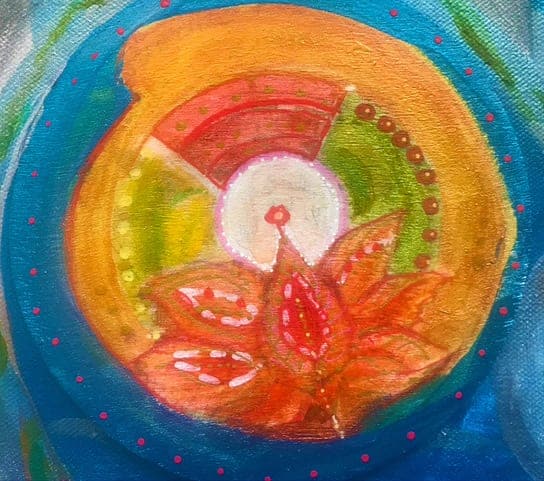Caregiving at a distance is extremely challenging during this time of the coronavirus threat. How do you care for someone when you can’t be directly with the person that you are caring for? So much of caregiving effort is based on the alive and present moment—the space between the caregiver and care receiver. The place where healing care can occur. If that space is through a telephone, skype, zoom, or Facebook, can you touch into the heart virtually?
We can make efforts to learn to touch the human spirit of the person that we are caring for through virtual technology. We can use the phone, skype, and zoom as aids in reaching out to another and to care give at a distance.
The Paramitas and Long-distance Caregiving
This is our reality at this point in time, and there are ways to TRY THIS, as a long-distance caregiver. A helpful Buddhist framework in your long-distance caring is the paramitas—six transcendent actions that carry others across the shores of suffering to the shores of awakening, so that as a caregiver you can alleviate another’s suffering through your compassionate heart of caring. This is especially true now when so many people face mental health challenges, and need support and connection.
We as caregivers may face the issue of needing to rouse our own generosity for others—especially if we are feeling depressed and sad. Sometimes what is necessary is to just take the first step and reach out to someone who needs care. To connect with our open heartedness and make a gesture of kindness towards someone who is in need.
The Paramita of Generosity
The first paramita is that of generosity—giving. We give material gifts, we give the gift of fearlessness, and the gift of the dharma and the teachings of the Buddha. Generosity practice lessens the suffering in the world. It enables us to extend caring to all living beings and to be generous towards ourselves and towards others. Try this: it’s as simple as putting your two hands out and putting one hand into the other hand. We give freely without attachment and expectation, motivated by our genuine concern for others.
The transcendent aspect of generosity is giving without expectation. We can give material resources to people, we can give dharma and friendship, and we can also give the quality of courage and fearlessness. It can be as simple as extending your beauty, smiles and loving- kindness to others. The obstacle to generosity/giving is poverty mentality—when we feel poor, we can’t give.
Generosity practice is a gateway and a willingness to raise the spirits of anyone that you come in contact with. It’s extending smiles and loving kindness to others, tenderness, and respect. It is conceived out of compassion and benevolence, and depends on not being needy. It is a portable practice.
Three Types of Generosity
There are three types of generosity:
- ordinary generosity of giving material goods
- the gift of fearlessness
- the gift of the teachings—dharma through inspiration and support
Generosity is free from desire, giving without expectation and opening up to the journey of wakefulness.

Virtual Practices for the Paramita of Generosity and Long-Distance Caring
These are all practices that can be done virtually, using whatever technology you and the care receiver are most comfortable with.
Conversation for Caring
- Establish a regular routine of distance caring, whether it is daily, twice weekly, or weekly. Be consistent and show up at the same time. The conversation for caring can be by phone, zoom, Facebook, and skype.
- Begin your conversation on caring by asking the person how they are feeling. There could be a variety of new and different feelings. Suggest some words to help identify feelings: are you feeling anxious, fearful, sad, lethargic, lonely, isolated, grieving? Probe a little deeper to see how the person is. This is a conversation on caring to identify the feelings and needs of the person and perhaps to discuss them in further detail.
- Identify needs, and apply your generosity.
Conversation for Courage
- After hearing how the person is doing, talk with them about what has inspired and given them hope and courage in their lives. Discuss this—perhaps include the courage of people caring for others in hospitals, singing on the balconies, janitors, teachers. And the courage that the person you are caring for has.
- Discuss their specific qualities of courage and bravery. List some of them together, such as strength, self-confidence, kindness, fearlessness.
- Discuss and share the stories of courageous people.
- Share the PAUSE PRACTICE together: Stop what you are doing and take three conscious breaths together. PAUSE, be where you are!
Conversation for Kindness
Share a loving-kindness practice together.
- Begin by saying each phrase aloud and invite them to repeat each phrase after you:
- May I enjoy happiness and its causes.
- May you enjoy happiness and its causes.
- May all beings everywhere be happy.
Through this practice, we uncover the ability to love, and welcome the opportunity to practice loving-kindness.
Virtual Meal Together
- Share a virtual meal together: plan it together, and talk during it. Discuss a book. Share recipes.
- Have a conversation about comfort food, what food provides ease and comfort to them?
- Stream music or listen to a poem together while dining. Make a toast together!

Letter from the Heart
Ask the person if there is someone they would like to write a letter from the heart to. It could be a thank you note, a note asking for forgiveness, a simple hello card, or card for a special occasion. Offer to write the note, or help them write it. This is a good activity that can provide joy and meaning!
Gratitude and Appreciation Exercise
- You can sit quietly together virtually and breathe and focus on appreciating this precious human life.
- Practice gratitude, each person saying what they are grateful for. I am grateful for your friendship. I am grateful for your call and for your attention to me.
Conversation for Calm and Comfort
- Ask what the person you are caring for is doing to provide calm and ease for themselves during the day. Name and discuss their activities.
- Sit quietly together. Imagine the open sky. Breathe easily.
- Listen to a piece of music together, chant, and or pray.
Understand Your Own Unique Gifts and Use Them!
Generosity begins with one’s self—and with taking time for yourself—especially if you are going to be able to remain a generous caregiver. Build your resilience! Part of the openness of giving is to give what is required at any moment, in any situation, it’s learning to give whatever you have, and to be open to your special nourishing qualities.
As caregivers we can give time, thanks, encouragement, and full attention—a long armed distance and tender embrace, smiles, listening, kindness, and good conversation. Generosity is conceived out of compassion, tenderness and benevolence, so respecting others is important.

Joyous generosity is transcendent and carries others to the shore of awakening. And along the way, we give with complete openness. We share our joyous generosity with humor and gentleness, practicing the paramita of generosity. We become humans who are genuinely able to help others, even at a distance.
Artwork by Jayne Feinberg Stuecklen. Jayne is a painter and graphic artist living in Nyack, NY. She is a Tibetan Buddhist practitioner and student of Chogyam Trungpa Rinpoche. Besides her career in art and design she has been a volunteer hospice worker and caregiver.

